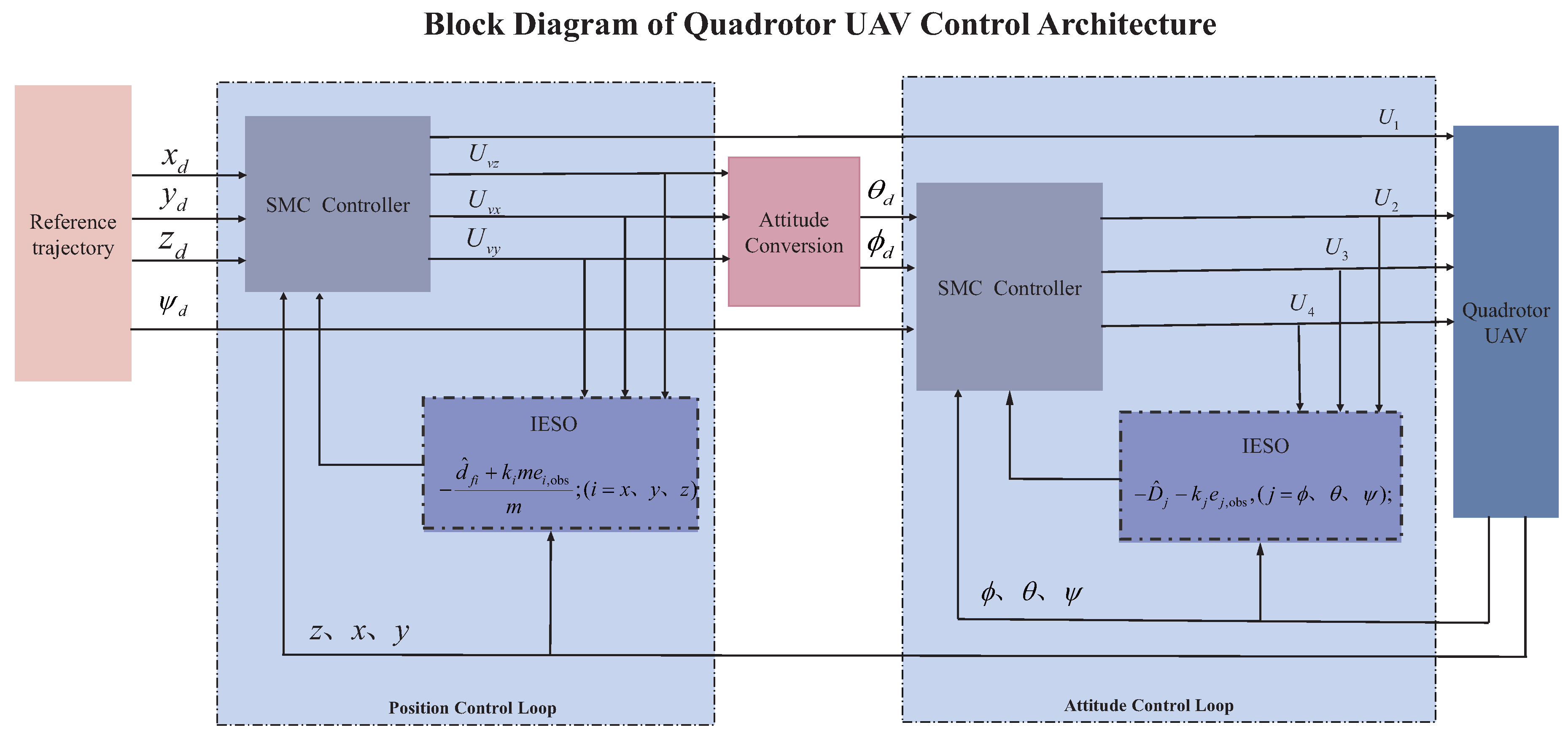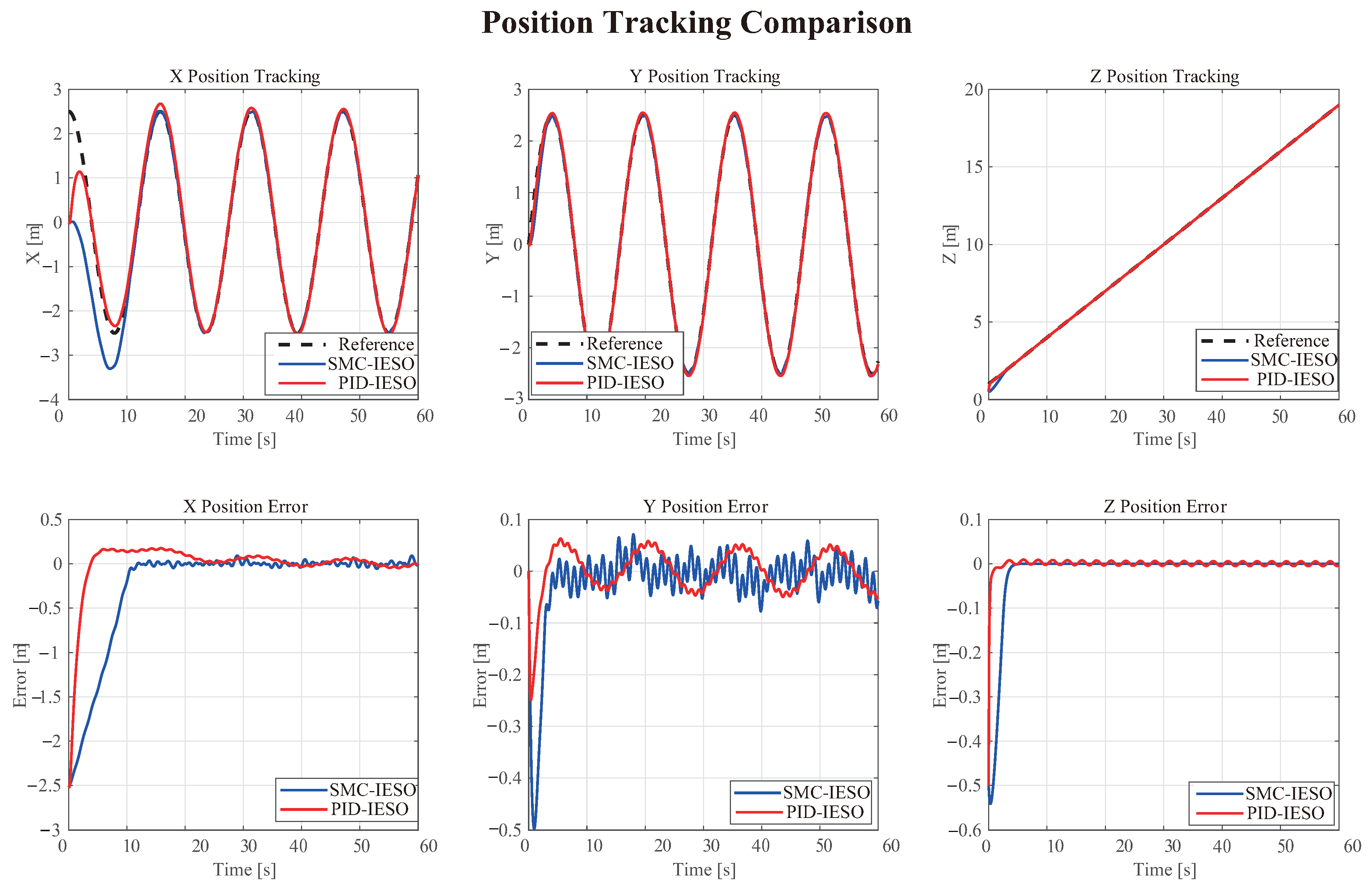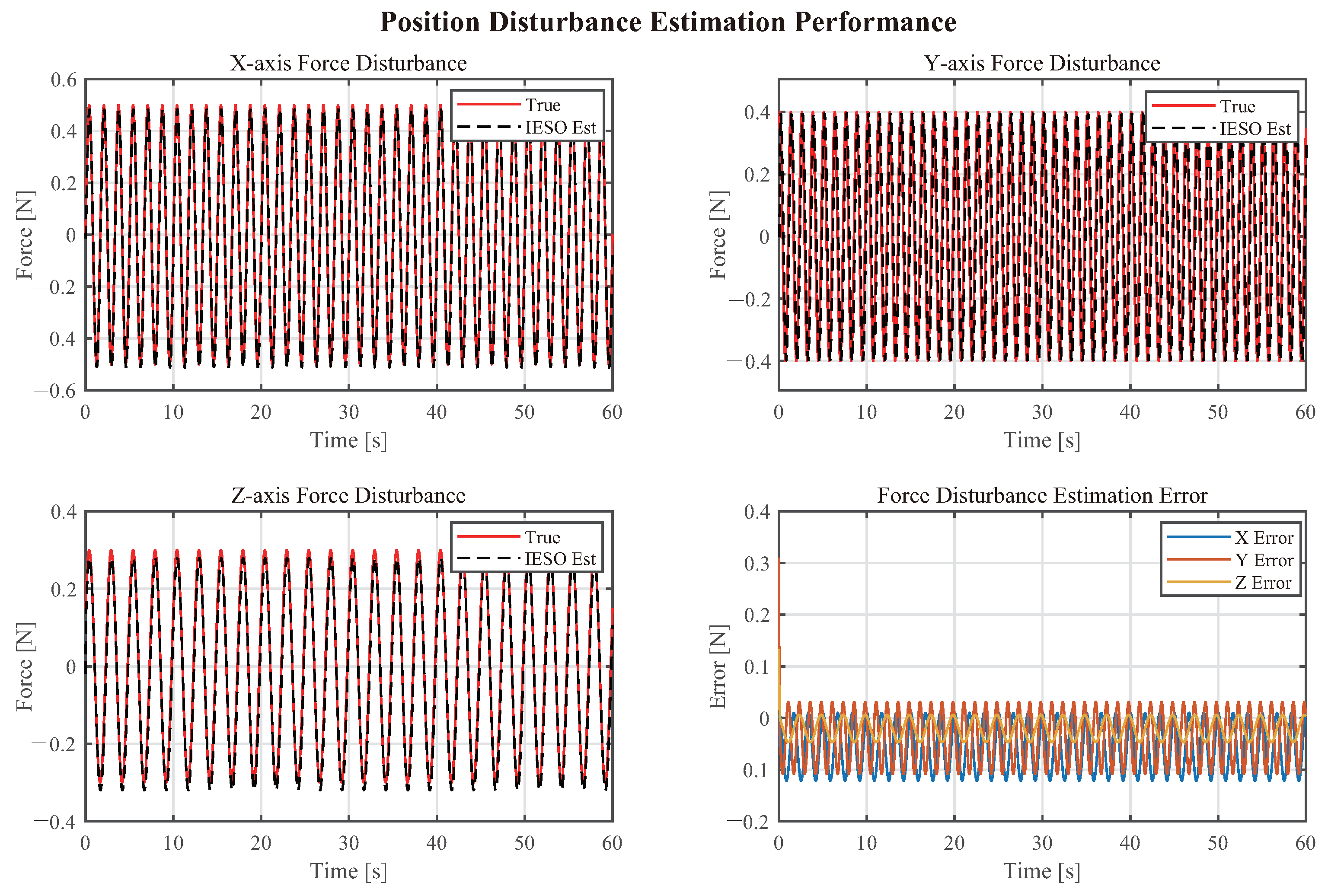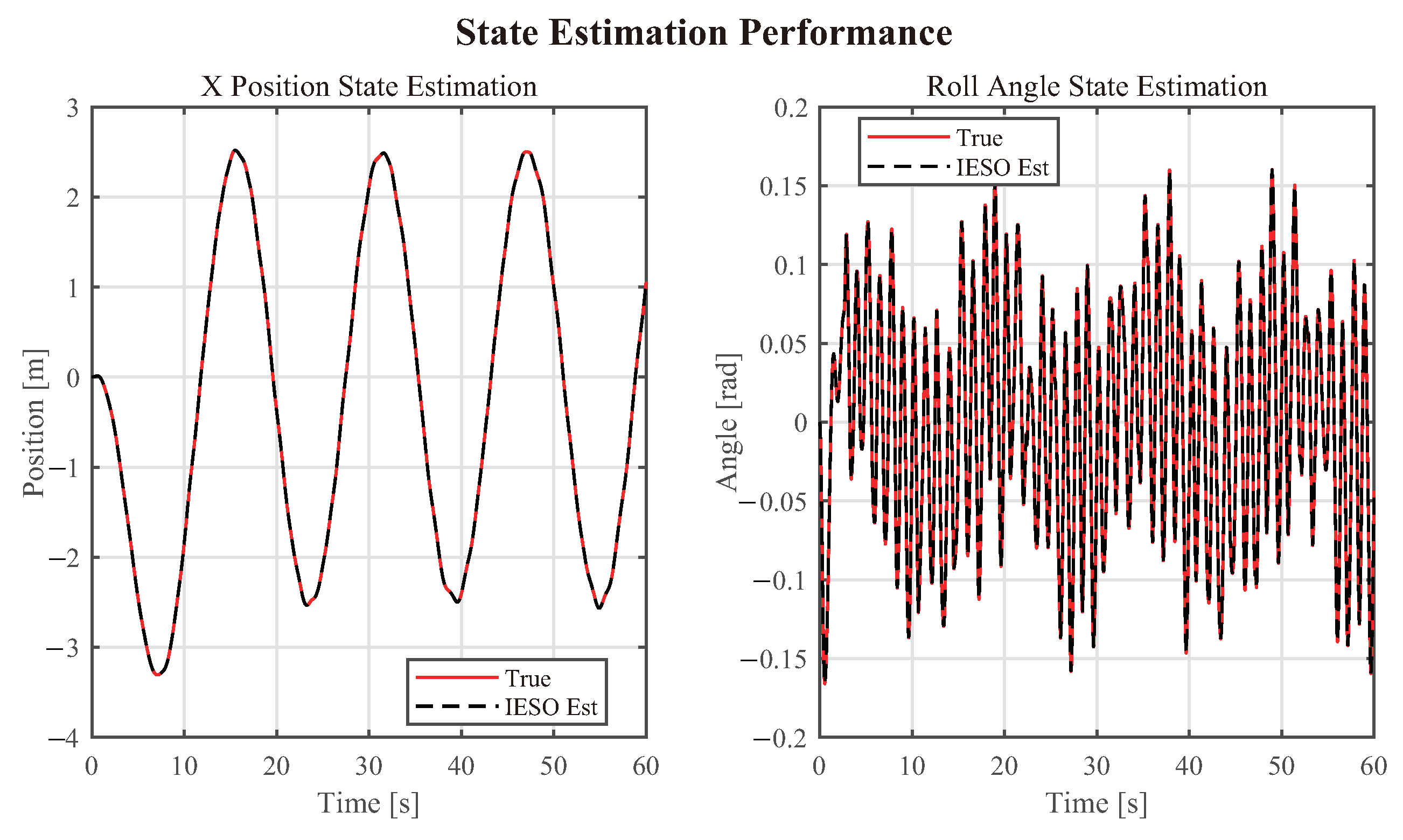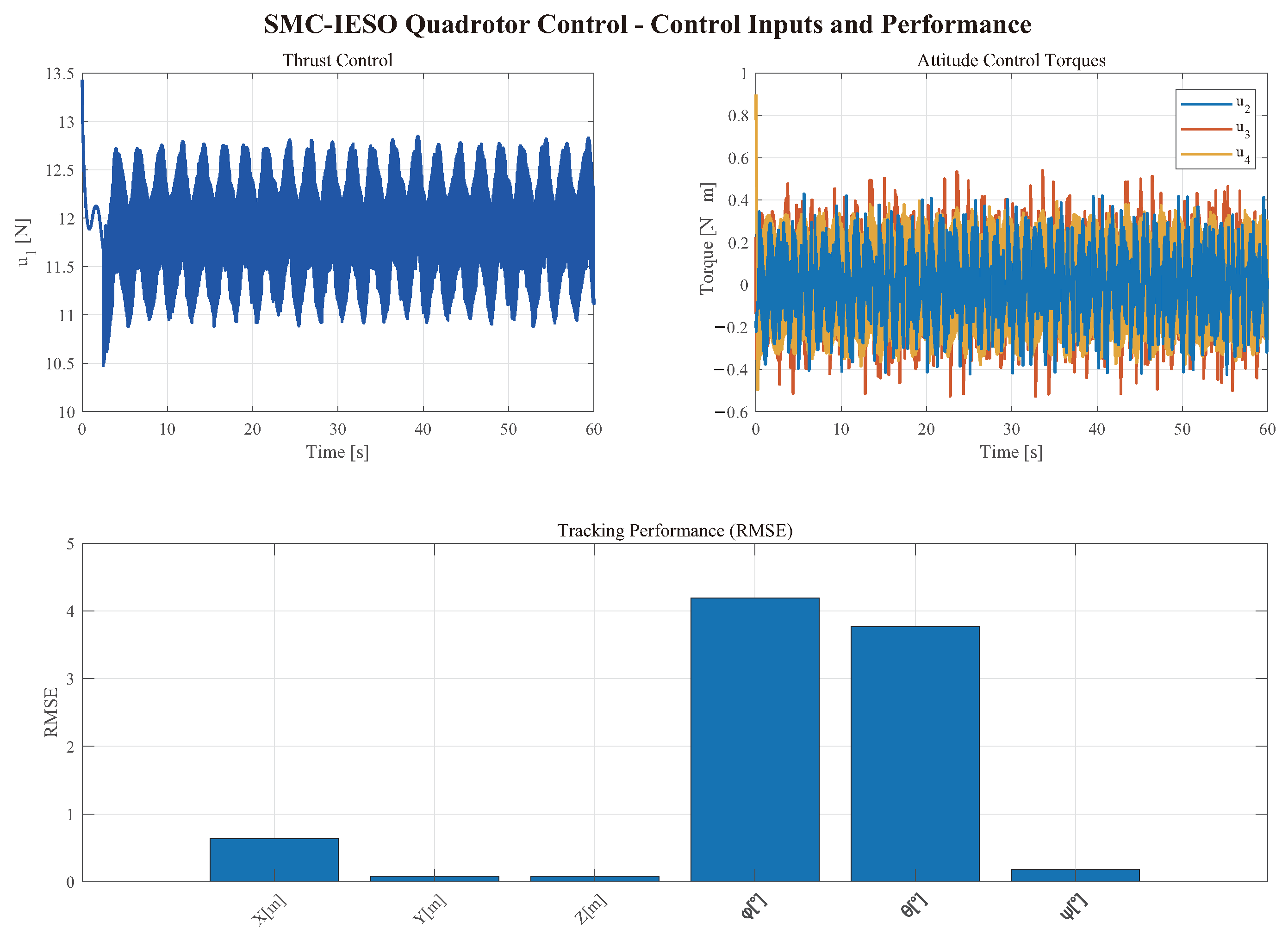1. Introduction
Quadrotor unmanned aerial vehicles (UAVs) have emerged as versatile platforms for diverse applications including surveillance, aerial photography, precision agriculture, environmental monitoring, search and rescue operations, and logistics delivery. In precision agriculture applications, control inaccuracies and vibrations can lead to uneven pesticide distribution, with spray deviation exceeding 30 cm potentially resulting in crop damage or inadequate pest control. In logistics delivery operations, landing point errors greater than 20 cm can cause package damage or mission failure, particularly in confined urban environments. These practical challenges underscore the critical need for robust, high-precision trajectory tracking control that can maintain stable flight performance under variable wind conditions and payload changes. Their structural simplicity, cost-effectiveness, vertical take-off and landing (VTOL) capability, and hovering stability have driven widespread adoption across military and civilian sectors [
1,
2].
The control of quadrotor UAVs presents significant challenges due to their inherent characteristics as underactuated, strongly coupled nonlinear systems. With six degrees of freedom but only four control inputs, quadrotors exhibit complex dynamics where translational and rotational motions are inherently coupled [
3]. Furthermore, practical flight operations subject these vehicles to various uncertainties including atmospheric disturbances [
4], payload variations, modeling errors, and actuator dynamics, which degrade tracking performance and compromise flight safety [
5,
6].
Various control strategies have been developed to address these challenges. Proportional-integral-derivative (PID) control remains popular due to its simplicity but exhibits limited robustness against uncertainties and disturbances [
7]. Feedback linearization techniques require accurate system models and demonstrate sensitivity to unmodeled dynamics [
8,
9]. Adaptive control methods can accommodate parameter variations but suffer from slow convergence rates under rapid parameter changes [
10,
11].
Sliding mode control (SMC) has attracted considerable attention for quadrotor applications due to its inherent robustness to matched uncertainties [
12,
13]. However, the discontinuous control action in conventional SMC induces chattering, which degrades performance and may damage actuators. While higher-order sliding modes [
14] and boundary layer techniques [
15] can reduce chattering, they typically compromise robustness.
Active Disturbance Rejection Control (ADRC) inherits many advantages of Proportional-Integral-Derivative (PID) control, leading to its great success [
16]: its control principle is error-driven rather than model-based; it draws on the best achievements of modern control theory—state observers; it fully utilizes the power of nonlinear feedback and makes it function effectively; as a promising method, ADRC treats internal dynamics and external disturbances as a combined “total disturbance”, and estimates and compensates it through the Extended State Observer (ESO) [
16,
17]. ADRC provides an operation mode without a model, effective disturbance rejection, and robust performance, making it increasingly popular in quadrotor control [
18,
19].
The reduced-order extended state observer (Reduced-Order ESO, RESO) has been proposed and has demonstrated advantages in various control scenarios. For instance, in the vibration control of fully clamped plates, the combination of SMC and RESO is adopted. By reducing the observer order, the computational burden is effectively reduced and the system’s anti-noise ability is enhanced. In the integrated guidance and control (IGC) design of hypersonic missiles, RESO is introduced to estimate the system’s lumped disturbances and perform feedforward compensation within the backstepping control framework, significantly improving the interception accuracy and robustness against maneuvering targets. However, RESO requires an accurate model of the controlled object [
20,
21].
Despite their individual merits, both SMC and ADRC have limitations. ESO performance is constrained by bandwidth limitations and phase lag, while SMC suffers from chattering. Recent research has explored combining these approaches to leverage their complementary advantages [
22,
23].
This paper presents a robust trajectory tracking control method for quadrotor UAVs that integrates sliding mode control with an improved extended state observer (SMC-IESO). The main contributions are:
- (1)
An improved sliding mode control law incorporating observation error compensation is developed. By introducing position observation error feedback and exploiting the relationship between observation and disturbance estimation errors, the proposed method reduces the required sliding gain, effectively suppressing chattering while maintaining robustness.
- (2)
A hierarchical control architecture is designed that exploits the time-scale separation between translational and rotational dynamics, decomposing the six-DOF tracking problem into cascaded position and attitude control loops.
- (3)
Rigorous stability analysis based on Lyapunov theory establishes the asymptotic stability of the closed-loop system, providing theoretical guarantees for practical implementation.
The remainder of this paper is organized as follows.
Section 2 presents the quadrotor dynamic model and formulates the control problem.
Section 3 details the SMC-IESO controller design for altitude, position, and attitude control.
Section 4 presents simulation results and performance analysis.
Section 5 concludes the paper and discusses future work.
2. System Modeling and Problem Description
The motion of a quadrotor UAV can be described in both the earth fixed frame
and the body fixed frame
. As shown in
Figure 1,
is used to describe global position and attitude, while
is used to analyze the body’s motion state and forces.
The position and velocity of the UAV in the inertial coordinate frame are represented as and , respectively. The attitude is represented using Euler angles, i.e., , corresponding to roll, pitch, and yaw angles. The angular velocity in the body coordinate frame is denoted as .
Assuming the UAV is a rigid body with mass
m and inertia matrix
, the system’s dynamic model includes both translational and rotational parts, with dynamics described as follows:
where
represents the gravitational acceleration vector,
is the rotation matrix from body to inertial coordinate frame,
represents the total thrust vector in the body coordinate frame,
is the translational disturbance (such as gusts and external forces),
is the control torque in the body coordinate frame, and
is the rotational disturbance. In this paper, it is assumed that
,
,
, and
are all bounded.
The relationship between Euler angles and angular velocities is described by the transformation matrix
, which takes the form:
Remark 1 (Singularity Avoidance). In this work, it is assumed that the quadrotor performs regular flight tasks, with attitude angles satisfying , thus ensuring and avoiding the control singularity problem.
The relationship between the rotational speed
of the
i-th rotor of the quadrotor and the resulting thrust and torques is as follows:
Expanding Equation (
1), the state-space expression of the system can be obtained:
The variables and their physical meanings are listed in
Table 1.
This research focuses on robust trajectory tracking control of the quadrotor UAV in the presence of unknown disturbances
. The control objective is described as:
where
and
are the desired position and attitude angles, respectively. To achieve this objective, this paper proposes a hierarchical control structure with inner and outer loops, which will be detailed in the next section.
3. Control System Design
For the strongly coupled nonlinear system with disturbances described by Equation (
1), we propose a hierarchical control architecture comprising position and attitude control loops. As shown in
Figure 2, The position loop employs the SMC-IESO method to estimate and compensate for composite disturbances in real-time, while the attitude loop utilizes SMC-IESO to track the desired attitude commands generated by the position controller. This hierarchical structure exploits the time-scale separation between translational and rotational dynamics, enhancing both disturbance rejection and trajectory tracking performance.
3.1. Vertical Channel Controller Analysis and Design
The vertical direction of the quadrotor is affected by the coupled action of main rotor force, gravity, and external disturbances (such as airflow, load changes, etc.), with its dynamic model expressed as:
Given the desired altitude trajectory
and its derivatives
and
, the altitude tracking error and its first-order derivative are defined as:
To achieve robust precise tracking in the closed-loop system, the following sliding surface is constructed based on sliding mode control theory:
where
is the sliding mode parameter, the magnitude of which determines the convergence speed and dynamic performance of the closed-loop error.
For the controlled object in Equation (
6), a traditional sliding mode control law is designed with the following structure:
where
is the sliding mode gain, used to ensure the system’s robustness against matched disturbances. The switching term
can effectively suppress the influence of system internal uncertainties and matched disturbances. However, the sliding mode controller in Equation (
9) tends to produce chattering phenomena in practical applications, and its ability to suppress parameter perturbations and unmodeled external disturbances is limited.
To address these shortcomings, this paper employs a third-order Extended State Observer (ESO) in the quadrotor’s vertical channel to accurately estimate the three state variables .
Specifically, the ESO design is:
where
are the estimated values of altitude, velocity, and disturbance, respectively, and
are the ESO observer gains.
To analyze the disturbance suppression performance, the observation errors are defined as:
Combining Equations (
6) and (
10), the observer error dynamic equations can be expressed as:
From the second equation in (
12), we can derive:
It can be observed that
contains
, and
is directly obtainable, so the disturbance estimation error can be reduced through
. Based on this, this paper designs an improved active disturbance rejection sliding mode control law:
This control law introduces an observation error compensation term
, utilizing the relationship in Equation (
13) to adjust and reduce the disturbance suppression error, thus allowing for a smaller sliding mode gain design, which in turn reduces the chattering phenomenon.
3.1.1. Observer Convergence Analysis
To analyze the convergence characteristics of the observer, define the observation error vector:
According to Equations (
10), (
11) and (
14), the observation error dynamic equation can be written in matrix form:
where:
The characteristic polynomial of matrix
is:
According to the Routh-Hurwitz stability criterion, the observer is asymptotically stable when the following conditions are satisfied:
Performing a Laplace transform on the above system, we can obtain the transfer function from the disturbance derivative
to the disturbance observation error
:
It can be found that when
, the transfer function (
20) has the following dynamic characteristics: (1) For low-frequency disturbances (
):
. Compared to the traditional ESO method (
), the IESO method further reduces the disturbance estimation error; (2) For high-frequency disturbances (
):
, the IESO method has similar characteristics to the traditional ESO method; (3) Stability condition: When
, the roots of the characteristic polynomial (
18) remain in the left half-plane, satisfying the Routh-Hurwitz criterion, without affecting the stability of the system.
3.1.2. Closed-Loop System Stability
Considering the dynamic characteristics of the sliding surface, select a quadratic Lyapunov function:
Taking the derivative of Equation (
21) and combining with the sliding surface definition in Equation (
8), we get:
Substituting the vertical channel dynamics from Equation (
6), we obtain:
Substituting the improved active disturbance rejection sliding mode control law from Equation (
14), we obtain:
Substituting Equation (
24) into Equation (
23), we obtain:
Substituting Equation (
13) into the above, we obtain:
Based on the above analysis, when the observer parameters satisfy the stability conditions in Equation (
19), the observation error
and its derivative
are bounded. Therefore, there exists a finite time
such that when
, we have:
where
.
By substituting Equation (
27) into Equation (
26), when the sliding mode gain is chosen to satisfy
, we have:
This indicates that the Lyapunov function is strictly decreasing, and according to Lyapunov stability theory, the sliding surface will converge to zero in finite time, meaning the system states will reach the sliding surface and slide on it.
Once the system reaches the sliding surface
, according to Equation (
8), we have:
The solution to which is:
This indicates that the altitude tracking error converges to zero at an exponential rate.
In summary, under the premise of satisfying the observer stability conditions in Equation (
19) and the sliding mode gain condition
, the proposed SMC-IESO control strategy can ensure the asymptotic stability of the quadrotor’s vertical channel, achieving precise tracking of the desired altitude trajectory.
Remark 2 (Performance Enhancement). Compared to traditional sliding mode control, the SMC-IESO strategy significantly reduces the required sliding mode gain through real-time observation and compensation of disturbances, thereby effectively mitigating the chattering phenomenon in control signals and improving the practicality of the control system.
3.2. x and y Axis Indirect IESO-SMC Control Strategy
Based on the design approach of the vertical channel controller, this section develops the analysis for the horizontal position control problem of the quadrotor UAV. Unlike the vertical channel, the position control of the x and y axes needs to be indirectly realized through adjusting the attitude angles (roll angle and pitch angle ), which increases the complexity and coupling of the system.
The dynamics equations of the quadrotor in the horizontal direction can be extracted from Equation (
4):
Given the desired position trajectories
,
and their derivatives, the horizontal position tracking errors are defined as:
Considering the indirect nature of horizontal position control, this paper adopts a two-step design method based on virtual control. First, the horizontal accelerations and are viewed as virtual control inputs, and the position loop control law is designed; then, the desired attitude angle commands are generated through the mapping relationship between virtual control and actual attitude angles.
3.2.1. Position Loop Virtual Control Design
To achieve robust tracking of horizontal positions, the following sliding surfaces are constructed:
where
are sliding mode parameters.
For the composite disturbances in the horizontal direction, third-order extended state observers are designed to estimate the states and disturbances in both the x and y channels:
where
and
are the virtual control inputs for the x and y directions, respectively, and
and
are the observer gain parameters.
Similar to the analysis of the vertical channel, the observation errors are defined as:
Based on the disturbance observation results, an improved active disturbance rejection sliding mode virtual control law is designed:
where
are sliding mode gains, and
are observation error compensation gains.
3.2.2. Attitude Angle Command Generation
The relationship between the virtual control inputs
and
and the actual control inputs is established. From Equation (
31), we know:
Through inverse operations, the desired attitude angle commands can be obtained:
where
is the virtual control input in the vertical direction, which has been determined in the previous section as:
3.2.3. Stability Analysis
Choose the Lyapunov function:
Taking the derivative of
and combining with the virtual control law (
37), we get:
By substituting the dynamics equations (
31) and the virtual control law (
37), following a derivation process similar to that of the vertical channel, when the observer parameters satisfy the corresponding stability conditions, it can be proven that:
where
.
Therefore, when the sliding mode gains are chosen to satisfy and , the horizontal position tracking errors will converge exponentially to zero.
Remark 3 (Attitude Angle Constraints). In practical applications, to ensure the flight safety and control effectiveness of the quadrotor, the desired attitude angles and should satisfy the constraint conditions , where is the maximum allowable attitude angle. When the calculated desired attitude angles exceed the constraint range, saturation processing should be performed.
Remark 4 (Hierarchical Control Architecture). By transforming horizontal position control into attitude angle commands, a hierarchical design of position outer loop and attitude inner loop is achieved. This structure fully utilizes the multi-time-scale characteristics of the quadrotor system, simplifies controller design, and ensures good tracking performance.
Remark 5 (Disturbance Compensation Mechanism). The IESO in the horizontal direction not only observes external disturbances but also compensates for modeling errors and parameter uncertainties to a certain extent. Through real-time disturbance estimation and feedforward compensation, the system’s robustness is significantly improved.
3.3. Attitude Inner Loop IESO-SMC Control
The attitude inner loop, as a key component of the hierarchical control system, is mainly responsible for tracking the desired attitude commands , generated by the position outer loop and the externally assigned yaw angle . The attitude inner loop has fast dynamic response capabilities, providing strong support for the quadrotor to achieve high-precision trajectory tracking.
According to the system state equations (
4), the dynamic model of the attitude subsystem can be extracted:
The attitude tracking errors and their first-order derivatives are defined as follows:
Considering the strong coupling nonlinearity, parameter perturbations, and disturbances of the attitude dynamics, the gyroscopic torque terms and external disturbances are unified as composite disturbances:
Thus, the attitude subsystem can be rewritten as:
3.3.1. Sliding Surface and ESO Design
For the three channels of attitude, sliding surfaces are constructed:
where
are sliding mode parameters.
To eliminate various disturbances in the attitude channels, third-order extended state observers are designed (taking the
channel as an example):
where
are ESO gains. Similarly, ESOs are designed for the pitch and yaw channels.
The observation errors for each channel are defined as:
3.3.2. Improved Active Disturbance Rejection Sliding Mode Control Law
Based on the sliding surface and extended state observation, the following attitude inner loop improved active disturbance rejection sliding mode controller is proposed:
where
,
,
are sliding mode gains, and
,
,
are observation error compensation coefficients. This structure utilizes real-time disturbance estimation and error compensation mechanisms to effectively enhance tracking robustness and reduce chattering.
3.3.3. Closed-Loop Stability Analysis
Select the Lyapunov function:
Taking the derivative of
and combining the simplified attitude dynamics and control law (
51), we have:
where
,
,
are observation error convergence margins. When
,
,
,
is strictly decreasing, and the attitude tracking errors will converge exponentially to zero.
Remark 6 (Multi-channel Decoupling and Robustness). The attitude inner loop adopts independent ESO observation and sliding mode compensation design for each channel, simultaneously providing good dynamic compensation effects for coupling, disturbances, and parameter changes.
Remark 7 (Multi-time-scale Fast Response). Utilizing the fast time-scale characteristics of the attitude inner loop, the attitude closed-loop under the hierarchical structure can provide a high-quality response base for position trajectory tracking.
Remark 8 (Sliding Mode Gain Optimization). After introducing observation error compensation, the sliding mode gain can be significantly reduced, thereby effectively mitigating control signal chattering and enhancing engineering practicality.
Remark 9 (Time-scale Separation). The hierarchical control structure adopted in this paper fully utilizes the time-scale separation characteristics of the quadrotor system. The time constant of the position outer loop is typically on the order of seconds, while the time constant of the attitude inner loop is on the order of milliseconds. This significant time-scale difference provides a theoretical basis for the hierarchical control design.
In summary, the hierarchical robust control architecture proposed in this section, through the SMC-IESO position control of the outer loop and the fast sliding mode attitude control of the inner loop, effectively solves the trajectory tracking problem of quadrotor UAVs. This control strategy not only handles the strong nonlinearity and coupling characteristics of the system but also effectively suppresses the influence of various external disturbances, providing theoretical support for high-precision control of quadrotor UAVs.
3.4. Parameter Design Methodology
- (1)
ESO Parameter Selection (Bandwidth Method) The ESO gains are selected using the bandwidth parameterization method [
17]. For a third-order ESO, the observer gains can be expressed as:
- (2)
Error Compensation Gain Selection The error compensation gains (
,
) are selected through iterative tuning: According to Equation (
20) matching observation gain.
5. Conclusions and Future Work
This paper presents a hierarchical control method integrating sliding mode control with an improved extended state observer (SMC-IESO) for quadrotor trajectory tracking under disturbances. The proposed approach incorporates three key innovations: (1) an improved sliding mode control law with observation error compensation that reduces the required sliding gain and suppresses chattering through position observation error feedback; (2) a third-order extended state observer for real-time estimation and compensation of composite disturbances; and (3) a cascaded control architecture exploiting the time-scale separation between position and attitude dynamics. Lyapunov analysis establishes the asymptotic stability of the closed-loop system. Simulation results demonstrate superior tracking performance, with position errors below 10 cm and attitude errors within 10°.
The future work will focus on the following aspects: laying the foundation for deployment on physical platforms, quantifying the real-time computational costs of controllers and observers, clarifying the relationship between key parameters and the required sampling rate and computing capacity. Conducting verification in more demanding scenarios, including fault-tolerant control when actuators or sensors fail, multi-machine collaboration in the presence of communication delays, and distributed control in large-scale clusters. Developing initialization strategies for observers when receiving or losing signals, and researching methods to alleviate drift problems through multi-source fusion technology, while analyzing the impact of time synchronization requirements on system performance.

